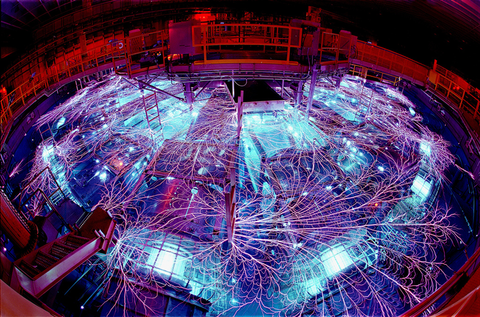
Testing a Sandia spectrometer at the NIST tungsten x-ray source. A bent quartz crystal, mounted in its metal holder, is at the far end of the brass wedge-shaped enclosure, facing the source illuminated by a green alignment laser.
Last spring, PML's x-ray calibration facilities were used in a pinch – a Z pinch, that is.
The Sandia National Laboratories' Z Pulsed Power Facility, or "Z machine," a nuclear fusion research device located in Albuquerque, New Mexico, is the most powerful x-ray generator in the world. In bursts of energy each lasting a few billionths of a second, the Z machine produces the hottest matter available on Earth, matter similar to that produced inside a star.
The facility's style of fusion, which uses the "Z pinch" method (more on that below), is used for a range of studies, including the development of fusion energy applications and understanding how stars work.
Detectors inside the Z machine record what happens during each fusion event in as much detail as possible. And specialized x-ray optics called "bent quartz crystals" are a key part of diagnosing those signals.
In a collaboration among PML's Radiation Physics Division, Artep Inc., and Sandia National Laboratories, a set of 18 bent quartz crystals had their energy and sensitivity responses calibrated at NIST's campus in Gaithersburg, Md., earlier this year. The curved crystals are designed to extend the energy range of the x rays that can be measured when emitted by Sandia's Z machine.
Bent quartz crystals are literally that: thin, rectangular slabs of the mineral quartz, about the length and width of a bar of soap but only 0.2 mm thick, spring-loaded into metal holders that force them to maintain their curvature. The Maryland-based technology company Artep Inc. developed and fabricated the 18 new crystals based on the crystal preparation and bending techniques originally created at NIST.
"There is a science and art to bending crystals, and we are one of the world's leaders in that area," says PML's Lawrence Hudson, who led the organization of the team that performed the calibrations.
The crystals are sensitive to hard x rays, within the spectral range of 10 keV to 100 keV, though their sensitivity within that range depends on how they were cut.
"These newly bent quartz crystals are similar to what we have been using with the Z machine before," says Sandia Labs' Guillaume Loisel, who hand-carried the crystals to Sandia after the testing, evaluation, and calibrations at NIST. "But we are using a new set of crystal cuts, or orientations, that are sensitive to a band of x-ray frequencies that haven't been observed accurately on the Z machine to date."
The purpose of the bent quartz is to disperse x-ray light. To an incoming x ray of the correct frequency, these optics act like prisms, causing the radiation to fan out into a sort of "x-ray rainbow," Hudson explains. Those dispersed rays then pass into a detector that records the frequency and intensity of that light. By spatially separating the frequencies from each other, the crystals allow detectors to pick up more subtle differences in the spectral signatures coming out of fusion events.*
However, each crystal has its own energy response. Calibrating how these optics transmit x rays of different energies ensures that researchers can determine the original emitted spectrum from the detected spectrum.

Gauging the optics' sensitivity to x rays of different energies required a second setup, involving an x-ray source passing through a combination of filters which created a known spectral shape. PML scientist Michelle O'Brien quantified the intensity of the x rays by measuring them with the national standard for assessing radiation exposure. NIST staff then compared the radiation exposure measured with the national standard to the exposure of a detector collecting the light that passed through a crystal. In this way they could provide correction factors, or an absolute sensitivity performance curve, that can be used for each crystal no matter what energy it is exposed to in the facility.
So far, Sandia's Loisel reports that "good-quality data" were obtained with the crystals on their first use in the Z machine.
Sandia's Z machine produces fusion events using the "Z pinch" method, in which a bank of capacitors stores a huge electric charge that is released instantaneously, with about 27 million amperes of current. At the center of the facility's giant drum – about three meters (10 feet) in diameter by six meters (20 feet) tall – is a tiny pellet of heavy hydrogen (deuterium) fuel housed in a container about the size of a spool of thread. The capacitors' intense burst of energy implodes or "pinches" the container evenly, causing the deuterium atoms in the pellet to compress into each other and fuse into heavier elements, a process that releases powerful x rays.
Along with helping to address other basic research questions, this type of crystal will likely be used within the Z machine to resolve a decade-long disagreement over elemental abundances within the Sun. Observations have suggested that the Sun has smaller amounts of certain elements than had been theorized. But models require more of those elements to explain other detected solar behavior, such as the Sun's temperature.
The Z machine, with its ability to reproduce conditions inside a star on a macroscopic scale, has already played a role in testing these elemental discrepancies.** Now, using more sophisticated detectors such as the ones that depend on the new crystals, researchers hope the facility will provide more information for solar scientists on this issue, Loisel says.
-- Reported and written by Jennifer Lauren Lee
*Different atomic states can be identified by their unique spectral signatures, spikes of intensity for key wavelengths of light.
**See "A higher-than-predicted measurement of iron opacity at solar interior temperatures." Nature. Vol. 517, January 2015. doi:10.1038/nature14048

